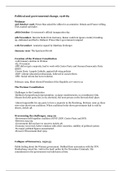Political and governmental change, 1918-89
Weimar
3rd October 1918, Prince Max asked the Allies for an armistice. Britain and France willing,
USA wanted surrender.
28th October- Government’s official inauguration day.
9th November- Bavaria broke from Germany, Kaiser could not ignore country breaking
up, abdicated and fled to Holland. Prince Max’s government resigned
11th November- Armistice signed by Matthias Erzberger
January 1919- The Spartacist Revolt
Creation of the Weimar Constitution
-19th January election in Weimar
-82.7% turnout
-SPD did not get a majority, had to work with Centre Party and German Democratic Party
(DDP)
-Centre Party- Largely Catholic, against left-wing policies
-DDP- Liberal educated professionals, believed in social reform
-SPD- Social reform but not revolution
February 1919, Ebert elected President of the Republic 277 votes to 51
The Weimar Constitution
Challenges to the Constitution
-Method of proportional representation. 35 large constituencies, no constituency link.
Chosen from the party-list, no by-elections, the next person on the list took their place.
-Almost impossible for any party to have a majority in the Reichstag. Between 1919-23 there
were nine short term coalitions. When coalitions broke down government had to rule by
decree, Article 48.
Overcoming the challenges, 1924-29
-Stresemann held together coalition of DVP, DDP, Centre Party and SPD.
-Between 1924-29:
-Government did not have to resort to Article 48.
-Economy recovered, better relations with other countries, stability of political system.
-No major political figures assassinated.
-However Stresemann died 1929.
Collapse of Democracy, 1930-33
Public feeling about the Weimar government. Disliked their association with the TOV.
Hindenburg voiced his, ‘stab in the back’ policy by the November Criminals. His
commitment to the government was lukewarm at best.





